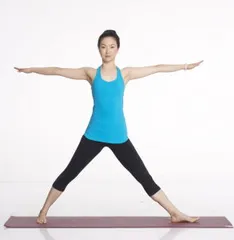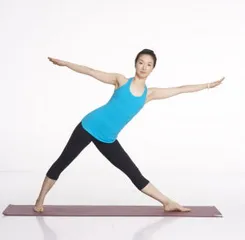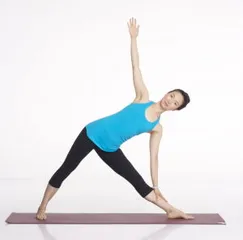How to do triangle stretching yoga (picture)
(1) Introduction to the styles
The key to triangular stretching yoga is that the lateral stretching of the body starts from the hip joint, not from our waist. This is the same as the forward stretching when standing forward bends from the hip. At the same time, since the body moves to one side during triangular stretching, the center of gravity must be pushed in the opposite direction to help maintain balance in this pose. In triangle stretching yoga, the center of gravity of the body is not downward, but open outward.
(2) Benefits:
Open the hips, flex the hip joints, strengthen the muscles of the front thighs, stretch the muscles of the back thighs and back, and exercise the neck.
(3) Taboos:
Triangle pose is a relatively safe pose suitable for most people.
For women over 6 months pregnant, the range should be smaller, the legs should not be too far apart, and you can also lean against the wall or support a chair on the side to help balance.
For people with lower back pain, the amplitude should be smaller, otherwise it may easily cause spinal rotation, which may aggravate lower back pain.
For students with knee injuries, leg or foot injuries, the range should not be too large. The legs should be separated relatively small and the range of lateral extension should be less.
(4) Action steps:
Inhale, bend your hands flat on your chest, bend your knees at the same time, jump your feet outward a leg length, stretch your arms to the sides, check that your feet are directly below your wrists, the outer edges of your feet are parallel to the outer edge of the cushion, and the three points on the soles of your feet are evenly stressed;
Turn the toes of the right foot outward 45° and the heels inward 45°, so that the heel of the right foot and the center of the left foot are in a straight line; the pelvis is turned straight and facing straight forward; the knees are lifted up; the muscles of both thighs are tightened; the tail vertebra is curled inwards, the abdomen is slightly retracted, the pelvis is slightly pushed forward, and the groin is unfolded; the shoulders are extended backward and sinking, the trapezius muscles are relaxed, the triceps are tightened, and the sockets of both elbow joints face upwards.

Inhale, extend the spine upward, push the pelvis to the left, and the arm drives the upper body to translate to the right;

Exhale, naturally place your right hand downward and gently on your calf or ankle, stretch your left arm upward, face your palms straight in front, and look straight in front.

Lift the knees up, tighten the thighs, tighten the buttocks and push forward, retract the abdomen slightly, stretch the lower ribs, and do not bulge the upper ribs, and keep the two ribs parallel;
Push the right shoulder forward, the left shoulder slightly backward, and expand the chest. The neck extends naturally along the spine. The head has not fallen off. Gently retract the chin, slowly twist the head, and look up in the direction of the left arm. If the body is stretched, the lower hand can touch the ground, but place it on the outside of the calf, and the fingertips touch the ground, so that the arm is perpendicular to the ground. At the same time, the center of gravity does not press down to maintain even breathing.

When withdrawing, inhale, tighten the muscles in your legs, lift your knees up, press down on the ground with three points under your feet, and slowly lift your upper body with your arms; exhale and drop your hands on both sides to turn your toes straight. Slowly turn to the other side.